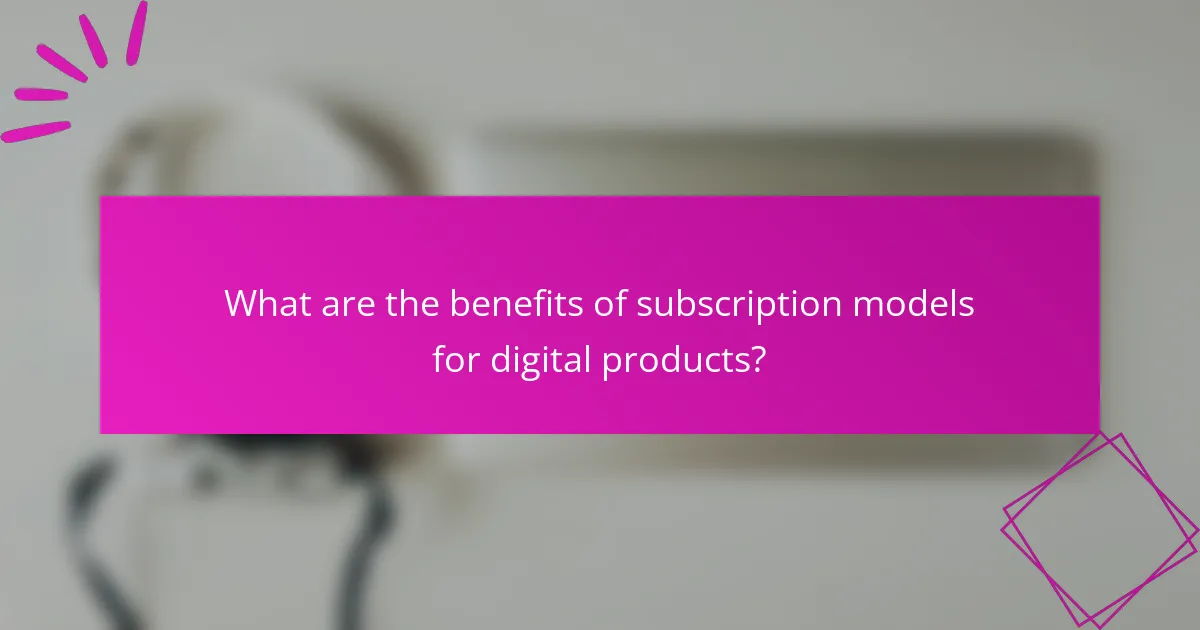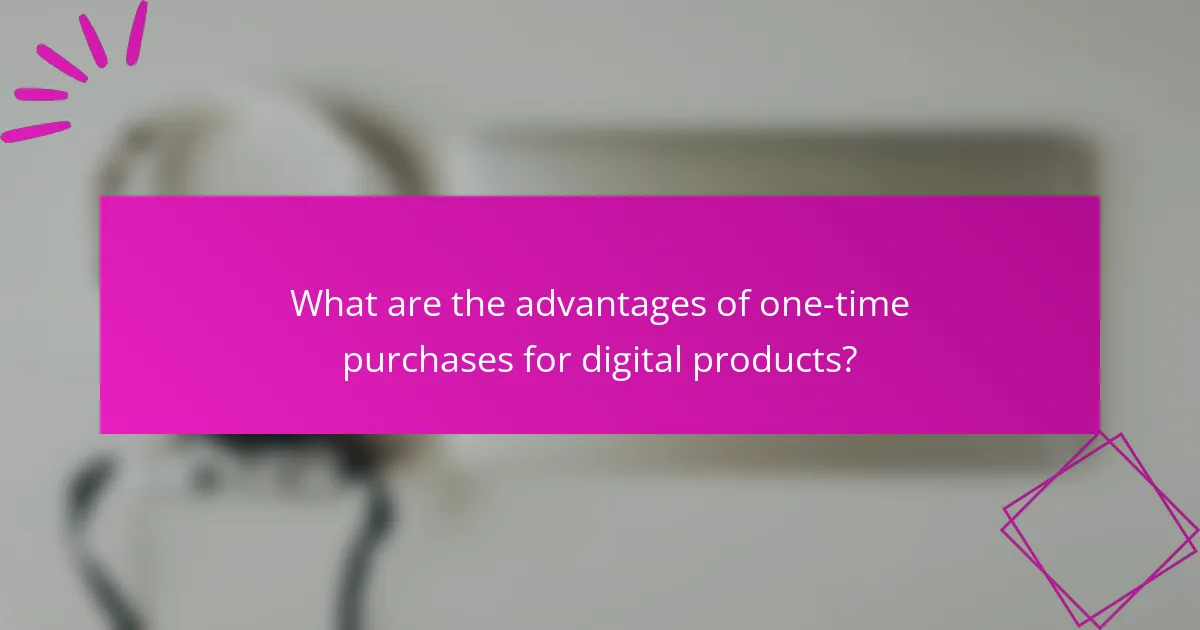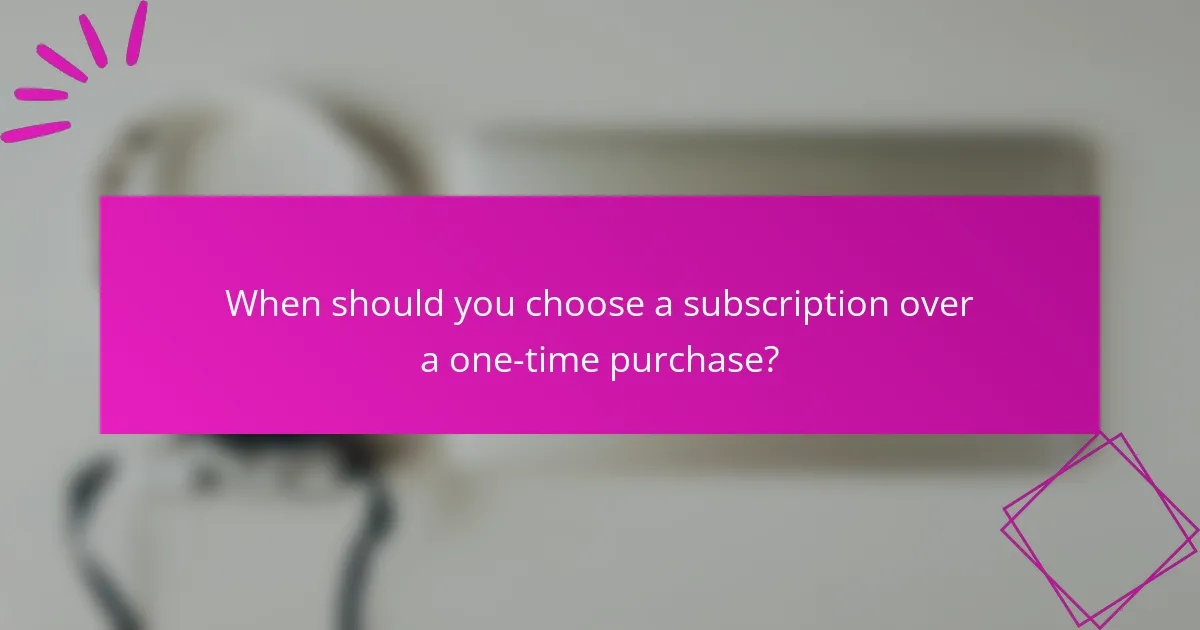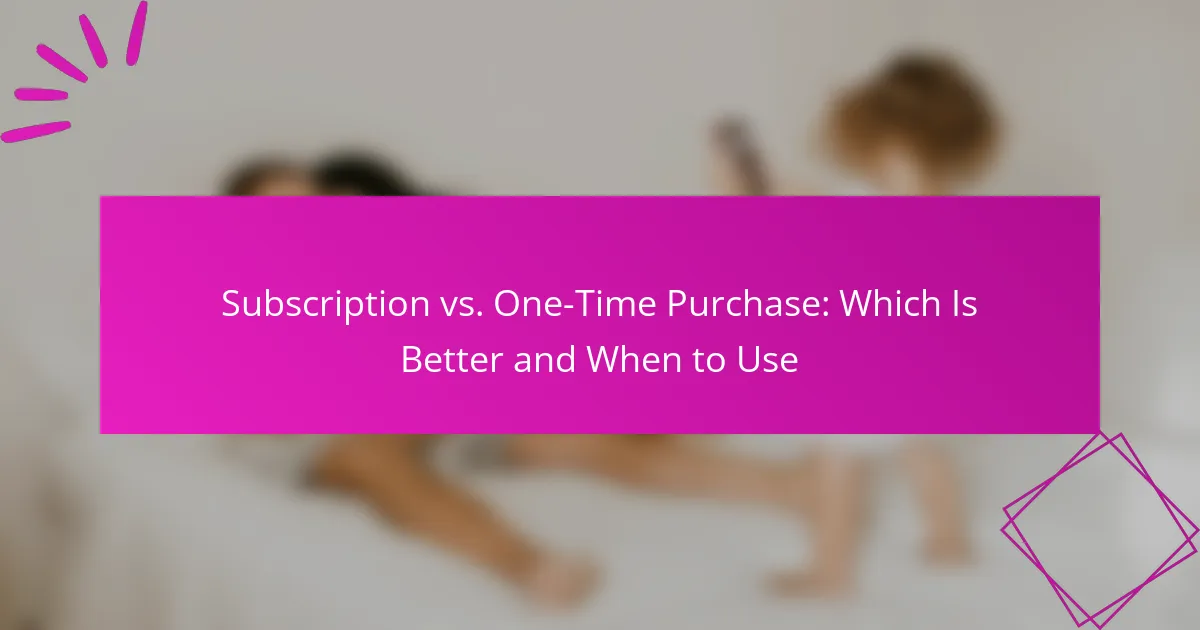When deciding between subscription models and one-time purchases for digital products, it’s essential to weigh the benefits of each approach. Subscriptions offer ongoing access and steady revenue, making them ideal for services that require regular updates, while one-time purchases provide immediate ownership without ongoing costs. Understanding your needs and preferences can help you choose the best option for your situation.

What are the benefits of subscription models for digital products?
Subscription models for digital products offer several advantages, including steady revenue for businesses and ongoing access to services for users. These models can enhance user experience while providing companies with predictable income streams.
Consistent revenue stream
Subscription models create a reliable and predictable revenue stream for businesses. This consistency allows companies to plan budgets and invest in growth initiatives without the uncertainty of fluctuating sales. For example, a software company may charge a monthly fee, ensuring a steady cash flow that can be reinvested into product development.
Access to regular updates
With subscriptions, users typically receive regular updates and new features as part of their plan. This ensures that they always have access to the latest tools and improvements without needing to make additional purchases. For instance, a music streaming service continuously adds new songs and playlists, enhancing the user experience over time.
Lower upfront costs for users
Subscription models often require lower upfront costs compared to one-time purchases, making them more accessible for users. Instead of paying a large sum upfront, users can spread the cost over time, which can be particularly appealing for expensive software or services. This model allows users to try products without a significant financial commitment.
Enhanced customer loyalty
Subscriptions can foster stronger customer loyalty as users become accustomed to the service and its benefits. Regular engagement through updates and customer support helps build a relationship between the user and the brand. Companies often offer incentives, such as discounts for long-term subscribers, to further enhance loyalty.
Scalability for businesses
Subscription models provide scalability for businesses, allowing them to grow their customer base without a proportional increase in costs. As more users subscribe, the fixed costs of maintaining the service are spread over a larger audience, improving profitability. This scalability can be particularly beneficial for digital products, where distribution costs are minimal.

What are the advantages of one-time purchases for digital products?
One-time purchases for digital products offer several key benefits, including immediate ownership and no ongoing payment obligations. These advantages make them appealing for consumers who prefer to pay upfront and avoid subscription fees.
Immediate ownership of the product
With a one-time purchase, customers gain immediate ownership of the digital product. This means they can access and use the product right away without waiting for a subscription period to begin. For example, buying a software license outright allows users to install and utilize the software immediately.
Immediate ownership also means that users are not dependent on a service provider’s ongoing support or availability. Once purchased, the product is theirs to keep, which can be especially important for software or digital media that users want to retain long-term.
No ongoing payment commitments
One-time purchases eliminate the need for ongoing payment commitments, which can be a significant advantage for budget-conscious consumers. Instead of worrying about monthly or annual fees, users make a single payment and can use the product indefinitely. This can lead to better financial planning and reduced stress over recurring charges.
Additionally, without ongoing payments, users avoid potential price increases that can occur with subscription models. This stability can be particularly appealing for those who want to avoid unexpected costs over time.
Potential for higher initial revenue
One-time purchases can generate higher initial revenue for businesses compared to subscription models. When customers pay upfront, companies receive the full payment immediately, which can improve cash flow. This is particularly beneficial for small businesses or startups that need immediate capital to invest in growth.
However, businesses should consider that while one-time purchases may yield higher initial revenue, they may not provide the same long-term income stability as subscriptions. Balancing these models can be crucial for sustained success.
Simpler purchasing process
The purchasing process for one-time purchases is generally simpler and more straightforward than that of subscriptions. Customers can quickly complete the transaction without needing to create accounts or manage ongoing subscriptions. This ease of use can enhance the overall customer experience and lead to higher conversion rates.
Moreover, a simpler purchasing process often results in fewer barriers to entry for consumers. For example, a user may be more inclined to buy a digital book with a one-time payment than to commit to a monthly reading subscription.

When should you choose a subscription over a one-time purchase?
Choosing a subscription over a one-time purchase is ideal when you need ongoing access to services or products that require regular updates or support. Subscriptions can provide continuous value, especially for services that evolve over time or for users who prefer spreading costs over a period.
When regular updates are essential
Subscriptions are beneficial when the product or service frequently receives updates, such as software or digital content. For example, a software subscription often includes the latest features and security patches, ensuring users always have access to the most current version without additional costs.
Consider services like streaming platforms, where new content is added regularly. A one-time purchase may not provide access to the latest offerings, making subscriptions a more attractive option for avid users.
For ongoing services or content
If you require continuous access to services or content, subscriptions are usually the better choice. For instance, cloud storage services charge a monthly fee for ongoing access to storage space, while a one-time purchase would limit you to a fixed amount.
Subscriptions can also apply to educational platforms that offer courses and materials over time. This model allows users to learn at their own pace while receiving new content as it becomes available.
When targeting long-term users
Subscriptions work well for businesses aiming to build a loyal customer base. By offering a subscription model, companies can foster long-term relationships with users who appreciate consistent access to products or services.
For example, subscription boxes for niche interests, like gourmet foods or hobby supplies, encourage repeat purchases and customer retention. This model often leads to higher lifetime value for businesses compared to one-time sales.

When is a one-time purchase the better option?
A one-time purchase is often the better option when users prefer outright ownership of a product, face budget constraints, or are looking for standalone items. This approach allows for immediate access without ongoing commitments or fees.
For users preferring ownership
Many consumers value the sense of ownership that comes with a one-time purchase. This option provides full control over the product, allowing users to use it indefinitely without worrying about subscription renewals or service interruptions.
For example, buying software outright means you can use it as long as your hardware supports it, without needing to pay for updates or new versions unless you choose to upgrade.
When budget constraints exist
One-time purchases can be more budget-friendly for those who want to avoid recurring costs. Instead of committing to monthly or annual fees, users can make a single payment that fits their financial situation.
This is especially relevant for products like books, tools, or software, where the upfront cost may be lower than the total of multiple subscription payments over time. For instance, if a subscription service costs $10 monthly, it would take only a few months to exceed the cost of a one-time purchase.
For standalone products
Standalone products, which do not require ongoing updates or services, are ideal candidates for one-time purchases. These items typically fulfill a specific need without the expectation of continuous support or enhancements.
Examples include physical goods like kitchen appliances or books, where the user benefits from immediate ownership without the need for subscriptions. In such cases, opting for a one-time purchase simplifies the decision-making process and often results in better value over time.

How do subscription models affect user engagement?
Subscription models can significantly enhance user engagement by providing ongoing value and fostering a sense of community. Users are often more likely to interact regularly with a service that they are subscribed to, as it encourages habitual usage and loyalty.
Increased Frequency of Use
Subscriptions typically lead to increased frequency of use compared to one-time purchases. When users pay for a service regularly, they are more inclined to utilize it consistently, resulting in higher engagement levels. For example, a streaming service may see users watching content multiple times a week if they are subscribed, whereas a one-time movie purchase might lead to a single viewing.
Community and Interaction
Subscription models often create a sense of belonging among users, fostering community and interaction. Many platforms offer forums, exclusive content, or events for subscribers, encouraging users to engage with both the service and each other. This social aspect can enhance user satisfaction and retention.
Personalization and Tailored Experiences
With subscription models, companies can collect data over time to personalize user experiences. This tailored approach can lead to higher engagement as users receive content and recommendations that align with their preferences. For instance, a music streaming service might curate playlists based on listening habits, making users feel more connected to the platform.
Potential for Churn
While subscriptions can boost engagement, they also come with the risk of churn if users feel they are not receiving adequate value. It is crucial for companies to continually assess user satisfaction and adapt their offerings. Regular feedback loops and updates can help mitigate churn and maintain high levels of engagement.

